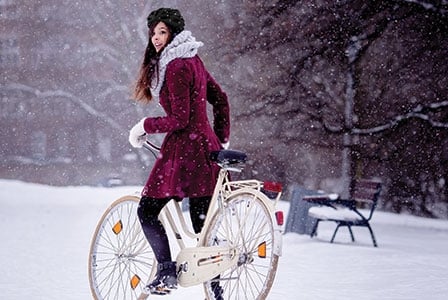
Yes, you can winterize your bike and ride it all year long! Learn these tips for safe cycling.
Below-freezing temperatures, snow-covered roads, and wind chill may not seem like ideal conditions for riding a bike. But more and more cyclists are hitting the roads in the winter, making their two-wheeled commute a year-round activity.
Patrick Blouin of Sudbury, Ontario, is one of them. When the first snow falls, Blouin swaps his summer hybrid for his winter mountain bike equipped with studded tires. “I decided that I was tired of missing out on winter cycling time and losing all my fitness,” he says. Not to mention the fact that cycling is a more affordable and environmentally friendly way to travel. But despite the benefits of winter cycling, it’s important to keep safety (and warmth) in mind when on the road.
Winterize your bike
Buy a winter bike
Snow, ice, and road salt are harsh on your bike. If you have an expensive road bike, you may want to pick up a cheaper bike for winter commuting. Tom Bietz, a senior bike mechanic at an outdoor store in Winnipeg, recommends an aluminum frame to get you through the winter months. “Steel is very susceptible to rust, whereas an aluminum bike can have quite a bit of water and snow on it and not rust as easily,” he says.
Swap tires
During mild conditions, knobby low-pressure tires are likely to give you enough traction, but if riding through packed snow and ice, you may want to opt for winter tires with a wide tread pattern and hardened steel spikes (called studs) to give you more grip if you do hit a patch of ice.
Fenders for protection
Road slush can have you arriving at your destination looking like you rolled around in a mud pit. Full fenders help keep the bike and the rider clean. “It’s a great solution to keep slush from coming up into your face, and in the rear, it keeps it from coming onto your back and from spraying up your legs,” says Emily Hein, who has been cycling year-round since 2006 and runs winter cycling clinics for HUB, a cycling education and advocacy group in Metro Vancouver.
Winter bike maintenance
Salt, snow, and ice can cause excessive corrosion. Keeping your bike as clean as possible is key to ensuring that it runs properly all winter long. Give your bike a wipe-down before bringing it inside to remove snow, and use an environmentally friendly degreaser to clean your chain and other moving parts. Remember to bring your bike to the bike shop in the spring for a post-winter clean-up. “After the winter, stuff’s going to start settling; that salt is going to start rusting your parts,” says Bietz.
Dress the part
While you may be tempted to break out your Canada goose parka, these heavy winter coats will turn your ride into a sauna on wheels. Remember, cycling is a physical activity—you need to be able to move. Plus, once you start riding, your core temperature will rise and you’ll quickly overheat if you’re wrapped in a down jacket.
Clothing
Bietz recommends getting dressed a few minutes before leaving the house and doing some push-ups or jumping jacks to increase blood flow and warm up your core before heading out on the bike. He recommends a soft-shell jacket and pants for cold-weather riding. This fabric is breathable, and it’s water and wind resistant to protect you from the elements.
Gloves
Numb hands are not only unpleasant but dangerous on a winter ride, yet thick winter gloves can make it difficult to operate gear shifters and brakes. “Pogies”—gloves that attach to the handlebars and gear covers to keep hands from freezing—are an essential winter bike accessory. They allow the cyclist to wear a thin liner glove, maintaining finger dexterity to manipulate the gear shifters and brakes.
Balaclava
It may make you look like a bank robber, but a balaclava (or face mask) is essential to protect your face from wind chill. Bietz recommends stretchy, soft balaclavas that are thinner around the mouth, allowing air to escape and avoiding fogging up your goggles.
Helmet cover
Since the majority of your body’s heat escapes through your head, protecting your noggin from the cold is essential to staying warm. Helmet covers that slip on top of a regular bike helmet can help.
Shoes
Winter cycling shoes will keep your tootsies dry and toasty, but Bietz says you don’t have to spend a fortune on specialty cycling shoes. A pair of hiking boots and thick wool socks can also do the trick. You can also wear your regular cycling shoes with winter booties (overshoes) to keep them insulated. a
Quick tips for safe winter cycling
Slippery conditions mean cyclists need to take extra precautions when riding in the winter months. Follow these tips for a safe winter commute.
Scout out your winter route
Before the snow hits the ground, ride around your neighbourhood and find a route that will allow you to make the most of bike paths and side streets to avoid high-traffic areas.
Stay visible
“Winter is the hardest time of the year for visibility for cyclists,” says Hein. Shorter days mean you’re likely to spend more time riding in the dark. A good set of clip-on LED lights and reflective gear will help make you visible to motorists and keep you safe on the road.
Ride slower than in summer
Expect your winter commute to take twice as long as in the summer. Riding at a slower pace gives you more control and ability to react and recover. Remember, braking will be more difficult in icy conditions, especially if snow cakes onto your wheels or brake pads, so allow yourself twice the stopping distance by anticipating stops and gradually reducing speed.
Know your limits
If you’re feeling unsure about road conditions, there’s no shame in leaving the bike at home and taking the bus.

